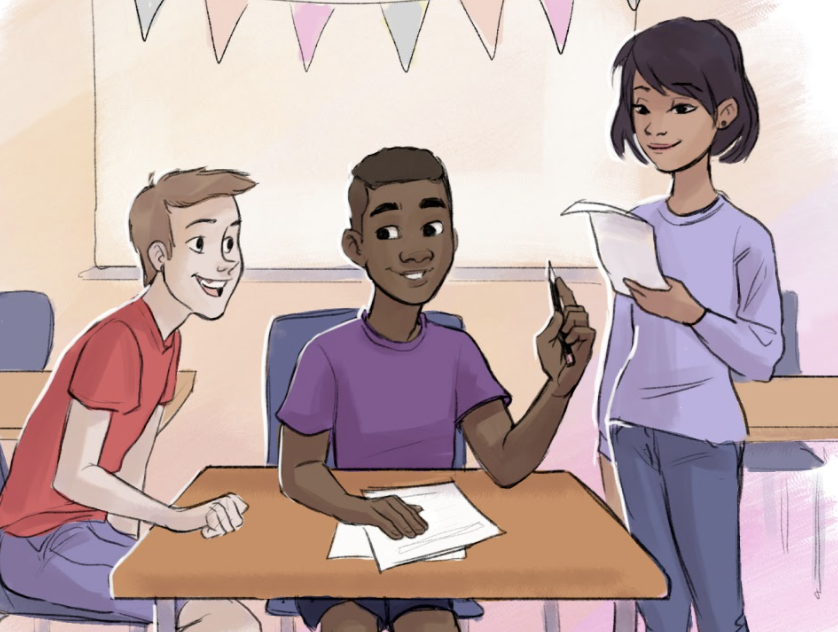Discuss racism head-on with your child, in simple terms they’ll understand. Regularly discuss race while correcting incorrect statements and beliefs, and expose them to friends and role-models of other races.
1 – Know why this is important
A lot of us believe children are ‘too young’ to discuss race (4), so don’t bring it up at all. This leaves our children to pick up their views on the complex, nuanced topic of race on their own, most likely from peers or TV. Still others teach their kids about race, but use a ‘colorblind approach,’ downplaying its importance. Research shows this strategy can make racial oppression worse, both in schools and society (9). It leads children to believe that racism is not a problem and they don’t need to do anything about it (3).
2 – This conversation can’t just happen once
Children are constantly picking up queues, from their peers as often as you. Whatever seems to help them get along, be accepted, avoid pain (physically or socially), will be reinforced until they might take it for granted (7). Your job then is to be the source of truth around race and multiculturalism regularly, to reinforce positive values and actions, and combat both overt racism and microaggressions (see footnote). Correct mistaken beliefs or observations your child has or makes every time they come up. It’s normal for them to have picked up the message that these topics are “off-limits”, so you’ll often have to start the conversations.
This will serve the double purpose of making your child comfortable with discussing difficult topics with you, which will be invaluable as they grow older! When they do bring the topic up themselves, see the conversation all the way through and ask what questions they have.
3 – What to say
Maybe we find talking to our children about race uncomfortable simply because we don’t know what to say. One key thing to remember is that you don’t need to explain the historical and social minutia of race like a college professor, but just keep pointing your child on the right track. Keep the answers simple (1).
You’ll notice that in the Little-Known Heroes books we’ve tried to boil racism down to concepts children are familiar with. The biggest one is unfairness. You can talk about how some people are treated unfairly in this way or that because of where they or their parents are from, because of the color of their skin, their religion, etc., and that it’s wrong. Acknowledge your child’s fears or anxieties about people who are different from them, while clarifying misconceptions immediately (1).
4 – Give your children positive experiences with people of all races
Where possible, make friends with families of races other than your own and have your children play together. Go out of your way to find places and entertainment that will present diversity to your child. Give them role-models of different racial and cultural backgrounds that they can relate to, such as those in the Little-Known Heroes (5). This way, they can learn both “people that look like me can do great things,” and “people that look differently from me can do great things.”
5 – Lead by example
“Do as I say, and as I do.” If you’re making an effort to do #4, you’re on the right track. Once your child knows your values and beliefs around race (because you’ve explicitly told them), and they feel comfortable asking you about them, live those truths yourself. Never make jokes about race and correct yourself and your peers when they make a joke or microaggression. When you mess up, own it, admit it, be better. Learn more about other races and cultures when you can and go make some friends with lives different than yours!
References
- Araujo, L., & Strasser, J. (2003). Confronting prejudice in the early childhood classroom. Kappa Delta Pi Record, 39(4), 178-182.
- Crary, E. 1992. Talking about differences children notice. In Alike and different: Exploring our humanity with young children, ed. B. Neugebauer, 11–15. Washington, D.C.: National Association
- Derman-Sparks, L., & Ramsey, P. G. (2006). What If All the Kids are White?. Early Childhood Education)(Early Childhood Education Series) 2nd (second) by Louise Olsen Derman-Sparks, Patricia G. Ramsey, Julie Olsen (2011) Paperback.
- Husband, T. (2012). “I don’t see color”: Challenging assumptions about discussing race with young children. Early Childhood Education Journal, 39(6), 365-371.
- Pine, G. J., & Hilliard, A. G. (1990). Rx for racism: Imperatives for America’s schools. Phi Delta Kappan, 71(8), 593-600.
- Sue DW (2010). Microaggressions in Everyday Life: Race, Gender, and Sexual Orientation. Wiley. pp. xvi. ISBN978-0-470-49140-9.
- Sutton, R. S., & Barto, A. G. (2018). Reinforcement learning: An introduction. MIT press.
- “Microaggressions” can be defined as brief and commonplace daily verbal, behavioural, or environmental indignities, whether intentional or unintentional, that communicate hostile, derogatory, or negative prejudicial slights and insults toward any group, particularly culturally marginalized groups (3).
- Johnson, L. (2002). “My eyes have been opened” White teachers and racial awareness. Journal of teacher education, 53(2), 153-167.
